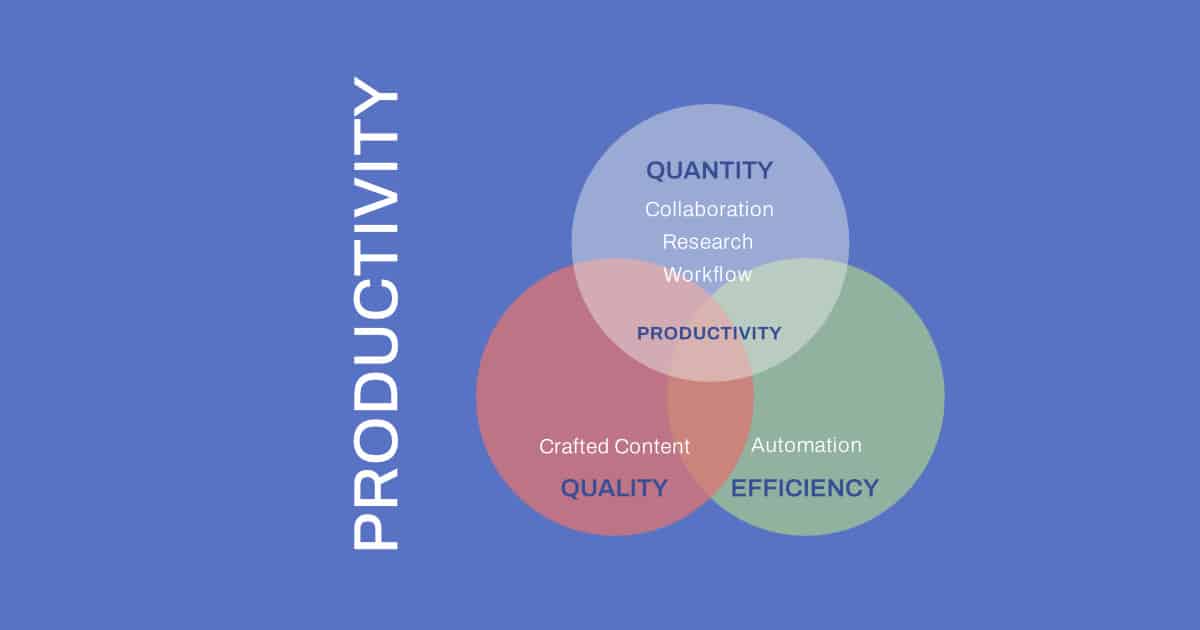Table of Contents
2. Focus and Productivity Tips
When it’s time to buckle down and focus, avoiding distractions is key. Working on your computer can make this difficult, as notifications and alerts constantly vie for your attention.
Now, while not everyone has the natural discipline to stay focused, fortunately there are several tools and strategies available to help improve concentration and productivity. Moreover, there are many platforms that provide options for working in a clutter-free environment, where only the essential tools are visible to the user.
WordPress is a good example of this, by selecting the Distraction Free option (⇧ ⌘ \ ) users can conveniently hide all the regular WordPress dashboard tools and continue writing in a distraction free workspace.
Other good examples include Trello, which allows users to focus on a single task or board by using its “Focus View,” and Notion, where users can toggle between a minimalistic interface and a full-featured workspace depending on their needs. Additionally, tools like Focus@Will offer music tracks scientifically designed to enhance focus and reduce distractions.
These tools can make a significant difference in maintaining productivity and ensuring that you can concentrate on the task at hand.
Interconnection of Productivity, Quantity, Quality, and Efficiency

Productivity, quantity, quality, and efficiency are not standalone metrics; they are interconnected elements that influence each other significantly. Striking the right balance among these factors is crucial for both effective research studying and successful business operations.
In both studying and running a business, productivity, quantity, quality, and efficiency are intricately linked concepts that collectively influence outcomes. Understanding how these elements interact can lead to improved performance and success.
Defining the Concepts
- Productivity refers to the total output produced within a specific timeframe. It is a measure of how much work is accomplished, often quantified as the number of tasks completed or products made.
- Quantity is a straightforward measure of the amount produced. While high quantity can indicate strong productivity, it does not inherently reflect the quality of the output.
- Quality assesses the standard of the output. High-quality work meets or exceeds expectations and requirements, which is crucial for long-term success.
- Efficiency measures how well resources are utilized to produce output. It focuses on minimizing waste and maximizing the quality of the output relative to the inputs used.
The Interplay Between These Elements
- Balancing Quantity and Quality: In a business context, focusing solely on quantity can lead to a decline in quality. For example, if employees are incentivized to produce more products quickly, they may overlook quality checks, resulting in defects and returns. Conversely, prioritizing quality can slow down production, potentially reducing overall output. Therefore, a balance is essential; businesses must strive to produce a sufficient quantity of high-quality products to meet demand without compromising standards.
- Efficiency Enhancing Productivity: Efficiency plays a critical role in enhancing productivity. When processes are optimized, resources are used more effectively, leading to higher output without a proportional increase in costs. For instance, if a team can streamline their workflow to reduce time spent on low-value tasks, they can increase their overall productivity while maintaining or improving quality.
- Quality as a Driver of Efficiency: High-quality outputs often lead to greater efficiency in the long run. When products or services meet high standards, there are fewer returns, complaints, or rework needed, which can save time and resources. This creates a positive feedback loop where quality improvements lead to efficiency gains, which in turn can boost productivity.
- Impact on Business Success: The interplay of these factors directly affects a business’s competitive edge. Organizations that manage to maintain high productivity while ensuring quality and efficiency are likely to experience reduced costs, higher customer satisfaction, and increased profitability. This holistic approach fosters a sustainable business model that can adapt to changing market demands.
To effectively link productivity and quality in any organization, it’s essential to adopt strategies that address both aspects simultaneously. One key approach is implementing quality management systems (QMS) that help streamline processes and reduce errors. Standardizing procedures across the organization ensures consistency, leading to fewer mistakes and higher quality outputs.
Additionally, investing in employee training is crucial, as well-trained staff can produce better work while being more efficient. Setting clear goals and metrics allows teams to focus on achieving specific productivity targets without compromising quality, fostering a balanced work environment.
Another important strategy is to encourage a culture of continuous improvement, where employees feel empowered to identify areas for enhancement. This can lead to innovative practices that boost both productivity and quality.
Utilizing technology and automation also plays a significant role; automated systems can handle repetitive tasks more efficiently, freeing up employees to focus on higher-value work that requires critical thinking.
By integrating these strategies, organizations can achieve a harmonious balance between productivity and quality, ultimately leading to better performance and success.
Quality Management Strategies
1. Implementing Quality Management Systems
Utilizing quality management systems (QMS) can significantly enhance both productivity and quality. By employing techniques such as process mapping, benchmarking, and cost-benefit analysis, organizations can identify inefficiencies and areas for improvement. This systematic approach helps streamline workflows, reduce defects, and ultimately increase productivity while maintaining high-quality standards
2. Standardizing Processes
Standardizing policies and procedures across the organization maximizes efficiency and ensures consistent quality. When everyone follows the same guidelines, it reduces variability in output, leading to fewer errors and higher quality products or services. This consistency allows teams to work more efficiently, as they spend less time troubleshooting issues that arise from inconsistent practices
3. Training and Empowering Employees
Investing in employee training is crucial for enhancing both productivity and quality. Well-trained employees are more capable of producing high-quality work and are often more efficient in their tasks. Empowering employees to take ownership of their work fosters a sense of pride and accountability, which can lead to better outcomes. When employees understand the importance of quality in their roles, they are more likely to prioritize it alongside productivity
4. Setting Clear Goals and Metrics
Establishing specific, measurable goals for both productivity and quality helps align efforts across the organization. For example, setting targets such as increasing production by a certain percentage while maintaining a specific quality standard encourages teams to focus on both aspects simultaneously. Regularly measuring performance against these goals allows for timely adjustments and continuous improvement.
5. Encouraging a Culture of Continuous Improvement
Fostering a culture that values continuous improvement can lead to sustained enhancements in both productivity and quality. Encouraging employees to identify areas for improvement and suggest solutions can lead to innovative practices that enhance efficiency and output quality. This culture not only boosts morale but also drives better performance across the board.
6. Utilizing Technology and Automation
Leveraging technology and automation can significantly improve productivity while maintaining quality. Automated systems can handle repetitive tasks more efficiently than humans, allowing employees to focus on higher-value activities that require critical thinking and creativity. This shift not only enhances productivity but also ensures that quality standards are consistently met
Health Matters and Productivity
Health and productivity are deeply interconnected, influencing not only individual performance but also overall workplace dynamics and organizational success. Prioritizing well-being is not just beneficial for employees; it is a strategic advantage for organizations aiming to thrive in today’s competitive landscape.
Here’s a closer look at how these elements interact and contribute to well-being in study and work environments.
The Link Between Well-Being and Productivity
Well-being encompasses how individuals feel and function on both personal and social levels. It includes mental, emotional, and physical health, which are crucial for optimal performance in any setting. Research indicates a direct correlation between employee well-being and productivity. For instance, a meta-analysis involving 339 studies found that when employees are in a state of good mental and physical health, they are more productive, resilient, and capable of managing stress effectively.
Moreover, happy workers are reported to be 13% more productive than their less happy counterparts, highlighting the significant impact of emotional well-being on work output. This relationship suggests that fostering a positive work environment can lead to enhanced productivity and better overall performance.
Strategies to Enhance Well-Being
Organizations can implement various strategies to improve employee health and well-being, which in turn boosts productivity. Some effective approaches include:
- Creating a Culture of Well-Being: Rather than just offering wellness programs, organizations should cultivate an environment that prioritizes employee health and happiness. This includes promoting work-life balance, recognizing achievements, and encouraging open communication.
- Redesigning Work Conditions: Adjusting job demands and work environments can significantly reduce stress and improve well-being. Research suggests that specific work conditions directly affect employee health and productivity.
- Comprehensive Wellness Programs: Implementing programs that address physical, mental, and emotional health can lead to reduced absenteeism and increased productivity. For example, employees who receive mental health support have shown a 23% increase in productivity.
The Broader Impact of Health on Productivity
The implications of health on productivity extend beyond individual performance. Organizations that prioritize employee well-being often experience lower healthcare costs and improved retention rates. Healthy employees are less likely to incur high medical expenses and are more engaged in their work, leading to better overall outcomes for the organization.
Additionally, workplace health initiatives can reduce presenteeism, where employees are physically present but not fully functioning due to health issues. This can significantly impact productivity levels.
Conclusion
By focusing on enhancing efficiency and quality, individuals and organizations can achieve higher productivity and better outcomes, ultimately leading to greater success and well-being.
In summary, the relationship between health, productivity, and well-being is crucial for both individuals and organizations. By fostering a supportive work environment and implementing effective wellness strategies, organizations can enhance employee satisfaction and productivity, ultimately leading to greater success and resilience in the workplace.





Leave a Reply
You must be logged in to post a comment.